
The Trofimoff valve (German : Trofimoff-Schieber) (also Trofimov, Troffimoff or Trofimof) is a springless pressure-compensation piston valve for steam locomotives.

The Trofimoff valve (German : Trofimoff-Schieber) (also Trofimov, Troffimoff or Trofimof) is a springless pressure-compensation piston valve for steam locomotives.
The function of the valve is to improve efficiency when running light, with the regulator closed, such as when descending hills. [1] The valve consists of the usual parts of a piston valve: two valve pistons with sealing rings, carried on a valve spindle driven by the valve gear. The difference with a Trofimoff valve is that the piston heads are free to slide on the spindle. When steam pressure is applied, under normal operating conditions, steam is admitted to the centre of the valve chest. This forces the valve heads apart against end stops on the spindle and into their normal working position. The valvegear works as usual.
When the regulator is closed, there is no pressure to force the piston heads apart. The pistons remain stationary in the centre of their travel, uncovering the valve ports. There is now a clear path through the valves and the working pistons, allowing free running for the coasting locomotive. [1]
The origins of this type of piston valve are not precisely known. It was probably developed in the 1920s in Germany, but its patents seem to have gone at that time to the Soviet State Railway. Other sources speak of it being developed by Bulgarian railway engineers. Russian sources claim that the valve was invented in 1908 by a Moscow Sorting Station service technician I.Trofimov (or Trofimoff, thus the name), but the Russian Revolution and Civil War slowed adoption, so the design gradually spread on the word-of-mouth, and was patented only in the 1920s.
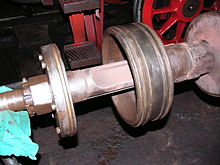

The Trofimoff valve comprises the valve spindle, the piston valve heads slotted onto them and the two supporting plates (Stützplatten). When the engine is running under load the valve heads are forced by steam pressure onto the support plates and work like standard pistons (Regelkolbenschieber). If steam admission ceases or, on a steam locomotive, the regulator is closed, the pressure drops, the valve heads remain in the inside dead centre position near the centre of the cylinder due to the tension of the piston rings. The valve spindle continues to move backwards and forwards with the support plates attached to it, without disturbing the valve heads. In this way, perfect pressure balance is achieved, thus ensuring excellent light-running conditions for the steam engine or locomotive.
The support plates fixed to the valve spindle also have a piston ring. This slows down the closing of the movable valve heads. Narrow gauge locomotives (such as the DR Class 99.23–24) do not have these piston rings. As a result, when the locomotive switches from running light to running under load there is a characteristic clicking noise as the pistons close. This piston ring on the support body was a further refinement by the former Meiningen repair shop.
So that the entire locomotive cylinder block does not have to be changed when the valves are damaged, they are housed in special chests. The valve chest consists of two elements which are forced into the cylinder block from the front and rear. Using special boring tools this chest can be bored out several times during maintenance. In the last illustration the junction of the two halves of the chest and the right-angled ports can be seen towards the rear. These are steam admission ports. Steam is admitted to the pistons of the steam engine through the front diagonal slits. The front area, outside the valve chest, is called the exhaust chest and discharges, via the exhaust pipe, the riser (Standrohr) and the blast pipe cap (Blasrohrkopf) centrally, underneath the chimney of the locomotive.
The motion of the valve heads alternately opens and closes the diagonal slits or steam ports, thus controlling the admission and exhausting of steam in the steam engine.

The vacuum brake is a braking system employed on trains and introduced in the mid-1860s. A variant, the automatic vacuum brake system, became almost universal in British train equipment and in countries influenced by British practice. Vacuum brakes also enjoyed a brief period of adoption in the United States, primarily on narrow-gauge railroads. Their limitations caused them to be progressively superseded by compressed air systems starting in the United Kingdom from the 1970s onward. The vacuum brake system is now obsolete; it is not in large-scale usage anywhere in the world, other than in South Africa, largely supplanted by air brakes.

The valve gear of a steam engine is the mechanism that operates the inlet and exhaust valves to admit steam into the cylinder and allow exhaust steam to escape, respectively, at the correct points in the cycle. It can also serve as a reversing gear. It is sometimes referred to as the "motion".

Main components found on a typical steam locomotive include:

The slide valve is a rectilinear valve used to control the admission of steam into and emission of exhaust from the cylinder of a steam engine.
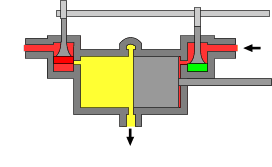
The uniflow type of steam engine uses steam that flows in one direction only in each half of the cylinder. Thermal efficiency is increased by having a temperature gradient along the cylinder. Steam always enters at the hot ends of the cylinder and exhausts through ports at the cooler centre. By this means, the relative heating and cooling of the cylinder walls is reduced.

The cylinder is the power-producing element of the steam engine powering a steam locomotive. The cylinder is made pressure-tight with end covers and a piston; a valve distributes the steam to the ends of the cylinder. Cylinders were initially cast iron, but later made of steel. The cylinder casting includes other features such as valve ports and mounting feet. The last big American locomotives incorporated the cylinders as part of huge one-piece steel castings that were the main frame of the locomotive. Renewable wearing surfaces were needed inside the cylinders and provided by cast-iron bushings.

Piston valves are one form of valve used to control the flow of steam within a steam engine or locomotive. They control the admission of steam into the cylinders and its subsequent exhausting, enabling a locomotive to move under its own power. The valve consists of two piston heads on a common spindle moving inside a steam chest, which is essentially a mini-cylinder located either above or below the main cylinders of the locomotive.

A snifting valve is an automatic anti-vacuum valve used in a steam locomotive when coasting. The word Snift imitates the sound made by the valve.
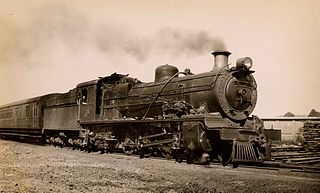
The South African Railways Class 16C 4-6-2 of 1919 was a steam locomotive.
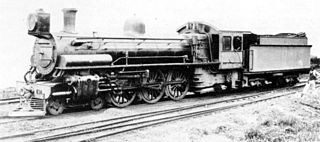
The South African Railways Class 10B 4-6-2 of 1910 was a steam locomotive from the pre-Union era in Transvaal.

The South African Railways Class 6L 4-6-0 of 1904 was a steam locomotive from the pre-Union era in the Cape of Good Hope.

The South African Railways Class 5B 4-6-2 of 1904 was a steam locomotive from the pre-Union era in the Cape of Good Hope.

The South African Railways Class Experimental 1 4-6-2 of 1907 was a steam locomotive from the pre-Union era in the Cape of Good Hope.

The South African Railways Class Experimental 2 2-8-0 of 1902 was a steam locomotive from the pre-Union era in the Cape of Good Hope.

The South African Railways Class Experimental 3 2-8-0 of 1903 was a steam locomotive from the pre-Union era in the Cape of Good Hope.
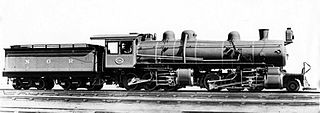
The South African Railways Class MA 2-6-6-0 of 1909 was a steam locomotive from the pre-Union era in the Natal Colony.

The South African Railways Class MD 2-6-6-2 of 1910 was a steam locomotive from the pre-Union era in Transvaal.
The South African Railways Class ME 2-6-6-2 of 1912 was a steam locomotive.

The Central South African Railways Rack 4-6-4RT of 1905 was a South African steam locomotive from the pre-Union era in Transvaal Colony.